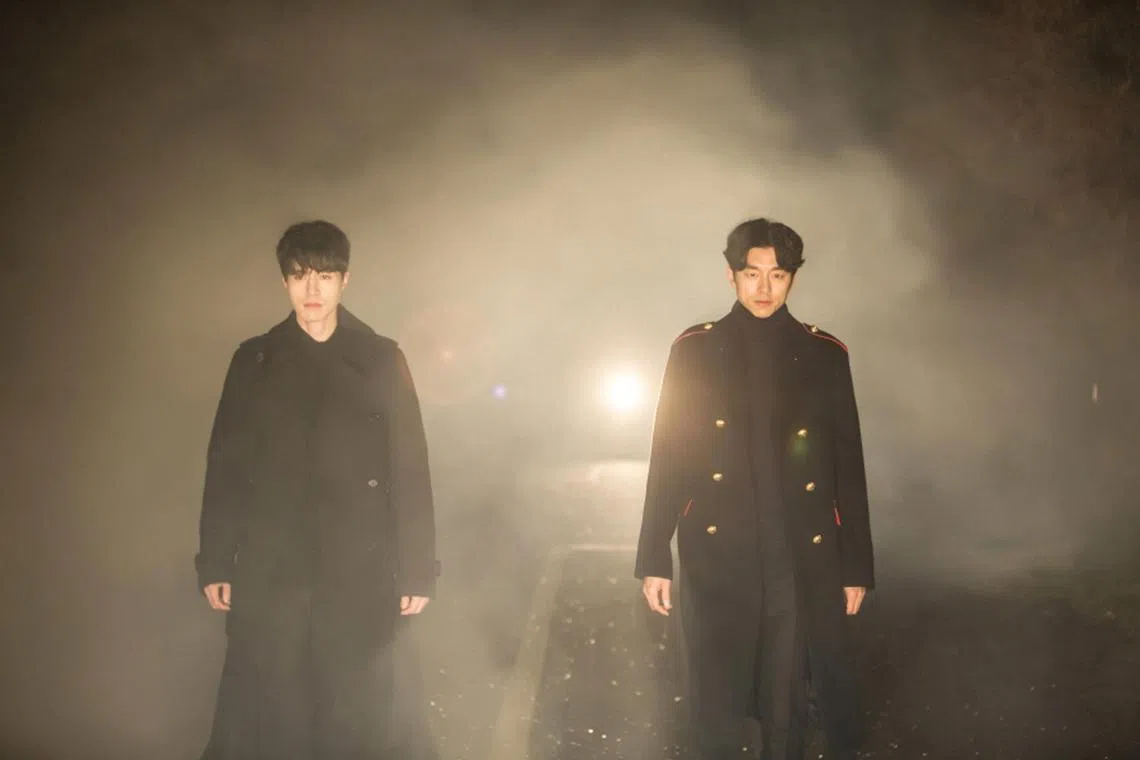South Korea’s grim reapers transform into pop culture icons in KPop Demon Hunters
Sign up now: Get ST's newsletters delivered to your inbox

The Saja Boys are a fictional K-pop group from the new Netflix animated film KPop Demon Hunters.
PHOTO: NETFLIX
Follow topic:
SEOUL – When the Saja Boys appeared on screen for the first time, dressed in floor-length black hanbok and wide-brimmed hats casting shadows over pale, painted faces, Ms Kang Chan-mi, a 32-year-old office worker in Seoul, immediately recognised the look.
“I knew instantly what they were,” she said. “If you’re Korean, it’s almost impossible not to.”
The Saja Boys, a fictional K-pop group from the new Netflix animated film KPop Demon Hunters,
The image is deeply familiar to Koreans. A pale-faced man, draped in black robes and wearing a gat – a traditional Korean hat made of horsehair and silk – has long signalled death in South Korean storytelling.
This is not the first time the grim reaper’s look has stepped into the limelight.
Most recently, on the dance competition show World Of Street Woman Fighter, Korean crew Bumsup built a performance around the figure, donning black shirts and gat to evoke the jeoseung saja’s chilling presence.
In South Korean television and film, grim reapers have often been reimagined as charismatic and charming figures.
In the 2016 hit drama Guardian: The Lonely And Great God, actor Lee Dong-wook played a modern version of the character, trading traditional robes and a gat for a tailored black suit and fedora.
The styling was contemporary, but the symbolism remained intact.

Lee Dong-wook (left) and Gong Yoo in Guardian: The Lonely And Great God.
PHOTO: OH!K TV
Tracing the allure of South Korean grim reapers
So, where did this image come from? Many trace it back to a June 1980 episode of the KBS series Legend Of The Hometown (unofficial title), a show known for its ghost stories.
It was there that the jeoseung saja took on its now-iconic appearance.
“We wanted to create a distinctly Korean image of death,” said the series producer Choi Sang-shik in a past interview. “Since death is associated with darkness, we dressed the grim reaper in black robes and contrasted it with a pale face and jet-black lips.”
But the grim reaper has not always looked this way.
According to the Encyclopedia Of Korean Culture by author Kim Deok-mook, the jeoseung saja originally appeared in shamanistic rituals as a military officer, dressed in official armour.
In many paintings from the Joseon era – including Gamjae Saja, which indicates one of the underworld messengers – he is depicted wearing bright red armour.
He was also a figure to be feared, as his arrival marked the moment a soul was taken from the world of the living. But he was not treated with hostility. In traditional funerary rites, the reaper is regarded with solemn respect.
“Since the reaper also serves as a guide through the long and difficult journey to the afterlife, mistreating him could bring misfortune to the deceased,” Mr Kim said. “That’s why families treat him with care during rituals.”
Even the number of reapers varies between tradition and pop culture.
In KPop Demon Hunters, there are five Saja Boys. In many South Korean dramas and films, the jeoseung saja often appears alone, an isolated figure quietly escorting the dead.

The Saja Boys are a fictional K-pop group from the new Netflix animated film KPop Demon Hunters.
PHOTO: NETFLIX
But in Korean shamanism, the number is typically three.
According to Mr Kim, in a traditional funerary ritual from Hwanghae Province, families prepare three bowls of rice, three pairs of straw shoes, and three sets of spoons and chopsticks. These offerings are meant to honour the three reapers guiding the soul from this world to the next.
That belief has also made its way into modern storytelling.
In the hit film Along With The Gods: The Two Worlds (2017), three grim reapers move together as a team led by a commander. THE KOREA HERALD/ASIA NEWS NETWORK

